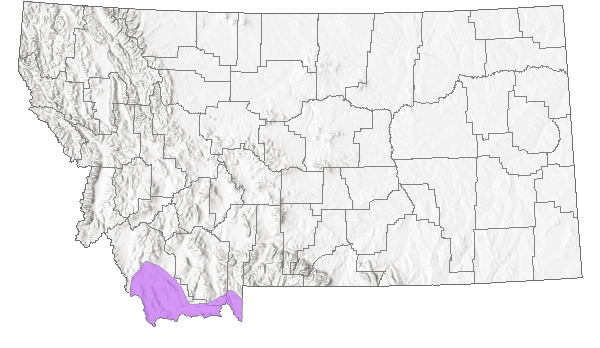View in other NatureServe Network Field Guides
NatureServe
Montana
Utah
Wyoming
Idaho
Wisconsin
British Columbia
South Carolina
Yukon
California
New York
Slender Thelypody - Thelypodium sagittatum
State Rank Reason (see State Rank above)
Known from numerous occurrences in extreme southwestern Montana.
General Description
Slender Thelypody is an herbaceous biennial or short-lived perennial with solitary, simple or branched stems that are 3-8 dm high and arising from a taproot. The lower leaves are 6-20 cm long and have petioles and broadly lance-shaped, entire-margined blades. The upper leaves are smaller, narrowly arrow-shaped, and they lack petioles. Foliage is glabrous or nearly so and has a thin, waxy coating. Flowers are densely clustered on ascending stalks in cylindric inflorescences that expand greatly when in fruit. Each flower has 4 separate sepals that are 3-7 mm long, 4 separate, lavendar petals that are 7-14 mm long and 1-3 mm wide, and 4 long and 2 short stamens. The ascending, straight, cylindric siliques are 18-53 mm long and less than 1 mm wide.
Phenology
Flowering and fruiting from the end of May to mid-July.
Diagnostic Characteristics
Differentiating Montana's three
Thelypodium species requires a technical key, such as those by AL-Shehbaz
in FNA 2010, Lesica et al (2012), and Giblin et al. [eds.] 2018. Other genera can also appear similar.
Thelypodium species have cylindrical siliques while species of
Arabis have flattened siliques.
Slender Thelypody -
Thelypodium sagittatum subspecies
sagittatum, SOC
* Stem Leaf: Auriculate-clasping, mostly sessile.
* Inflorescence: Terminal racemes do not considerably elongate in fruit (opened flowers crowded at tip).
* Flowers: Petals light to deep violet-purple, 1-3 mm wide. Anthers 2-3 mm long.
* Fruit: Siliques often straight, 0.5-1.2 mm wide.
* Seeds: Flat.
* Habitat: Moist, often alkaline meadows that dry by summer, desert plains to lower mountains. In the montane zone of Montana.
Northwestern Thelypody -
Thelypodium paniculatum, SOC
* Stem Leaf: Auriculate-clasping, mostly sessile.
* Inflorescence: Terminal racemes do not considerably elongate in fruit (opened flowers crowded at tip).
* Flower: Petals lavender to purple, 2.5-5 mm wide. Anthers 1-2 mm long.
* Fruit: Siliques often straight, 1.3-2.3 mm wide.
* Seed: Plump.
* Habitat: Wet meadows and streambanks. In the montane zone of Montana.
Entire-leaved Thelypody -
Thelypodium integrifolium subspecies
integrifolium* Stem Leaf: Bases are cuneate to attenuate, not auriculate, sagittate, or auriculate clasping; sessile.
* Flower: Petals white to purple, 4-7 mm wide
* Fruit: Siliques ascend, 1-3 cm by 0.7-1.1 mm long with a 0.3-2.0 mm long stipe.
* Habitat: Moist to wet, alkaline or saline meadows in the plains, valleys, and montane zones of Montana.
Species Range
Montana Range
Range Descriptions

 Native
Native
Range Comments
Southeastern WA to CA, east to MT and WY.
Observations in Montana Natural Heritage Program Database
Number of Observations: 34
(Click on the following maps and charts to see full sized version)
Map Help and Descriptions
Relative Density

Recency



 (Observations spanning multiple months or years are excluded from time charts)
(Observations spanning multiple months or years are excluded from time charts)
Habitat
Moist, alkaline meadows, often with greasewood or shrubby cinquefoil, in the valley to montane zones. Thelypodium sagittatum, grows in alkaline meadows that are often dry, but may be wet in the early part of the season (Al-Shehbaz 1973).
Ecological Systems Associated with this Species
Stewardship Responsibility
Threats or Limiting Factors
STATE THREAT SCORE REASON
Reported threats to Montana's populations of Slender Thelypody are currently assigned as unknown. Potential threats due to livestock trampling and grazing are negligible according to reported data (MTNHP Threat Assessment 2021).
References
- Literature Cited AboveLegend:
 View Online Publication
View Online Publication Hitchcock, C.L. and A. Cronquist. 2018. Flora of the Pacific Northwest: An Illustrated Manual. Second Edition. Giblin, D.E., B.S. Legler, P.F. Zika, and R.G. Olmstead (eds). Seattle, WA: University of Washington Press in Association with Burke Museum of Natural History and Culture. 882 p.
Hitchcock, C.L. and A. Cronquist. 2018. Flora of the Pacific Northwest: An Illustrated Manual. Second Edition. Giblin, D.E., B.S. Legler, P.F. Zika, and R.G. Olmstead (eds). Seattle, WA: University of Washington Press in Association with Burke Museum of Natural History and Culture. 882 p. MTNHP Threat Assessment. 2021. State Threat Score Assignment and Assessment of Reported Threats from 2006 to 2021 for State-listed Vascular Plants. Botany Program, Montana Natural Heritage Program, Helena, Montana.
MTNHP Threat Assessment. 2021. State Threat Score Assignment and Assessment of Reported Threats from 2006 to 2021 for State-listed Vascular Plants. Botany Program, Montana Natural Heritage Program, Helena, Montana.
- Additional ReferencesLegend:
 View Online Publication
View Online Publication
Do you know of a citation we're missing? Al-Shehbaz, I. A. 1973. The biosystematics of the genus Thelypodium (Cruciferae). Contributions from the Gray Herbarium No. 204:3-148.
Al-Shehbaz, I. A. 1973. The biosystematics of the genus Thelypodium (Cruciferae). Contributions from the Gray Herbarium No. 204:3-148. Haglund, B.M. 1972. Ecological effects of weather modification, Bangtail Ridge, Bridger Range, Montana: relationships of pocket gophers (Thomomys talpoides) to time of snow melt. M.Sc. Thesis. Bozeman, Montana: Montana State University. 26 p.
Haglund, B.M. 1972. Ecological effects of weather modification, Bangtail Ridge, Bridger Range, Montana: relationships of pocket gophers (Thomomys talpoides) to time of snow melt. M.Sc. Thesis. Bozeman, Montana: Montana State University. 26 p. Lesica, P., M.T. Lavin, and P.F. Stickney. 2012. Manual of Montana Vascular Plants. Fort Worth, TX: BRIT Press. viii + 771 p.
Lesica, P., M.T. Lavin, and P.F. Stickney. 2012. Manual of Montana Vascular Plants. Fort Worth, TX: BRIT Press. viii + 771 p. Lesica, P., M.T. Lavin, and P.F. Stickney. 2022. Manual of Montana Vascular Plants, Second Edition. Fort Worth, TX: BRIT Press. viii + 779 p.
Lesica, P., M.T. Lavin, and P.F. Stickney. 2022. Manual of Montana Vascular Plants, Second Edition. Fort Worth, TX: BRIT Press. viii + 779 p.
- Web Search Engines for Articles on "Slender Thelypody"





